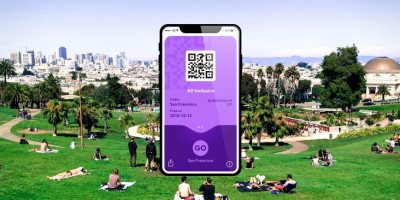Main Menu
-
Itineraries & Vacations
- Itineraries & Vacations
- BY TYPE
- Escorted Group Tours
- Road Trips in The US™
- BY INTEREST
- Route 66
- National Parks
- BY SPECIAL OFFER
- GIFT CARD
- Discount Coupons
- Tours in Major Cities
-
Travel Guides
- Travel Guides MOST VISITED CITY
- New York City Guide
- TOUR GUIDES BY CITY
- Miami - Travel Guide
- Los Angeles - Travel Guide
- San Francisco - Travel Guide
- Las Vegas - Travel Guide
- Chicago - Travel Guide
- Washington DC - Travel Guide
- Boston - Travel Guide
- San Diego - Travel Guide
- Orlando - Travel Guide
- New Orleans - Travel Guide
- TRAVELING IN THE US
- Good to Know
- Lodgings
- Disney Travels™
SFMOMA Museum of Modern Art of San Francisco
What you need to know
The Most Important Museum of Modern and Contemporary Art on the West Coast. Categories: San Francisco - Travel Guide - What to see
The SFMOMA in San Francisco
The San Francisco Museum of Modern Art (SFMOMA) is a true cultural icon of San Francisco, a city long celebrated for its vibrant artistic spirit and multicultural history. Located in the heart of the SoMa district, SFMOMA is regarded as one of the most important modern and contemporary art museums worldwide. With its extensive collection of over 33,000 works, it is a must-visit destination for all art and culture enthusiasts.Its collection includes masterpieces by renowned and beloved artists such as Jackson Pollock, Mark Rothko, Andy Warhol, and Frida Kahlo, as well as numerous works of photography, design, architecture, and media art. Additionally, SFMOMA is celebrated for its extraordinary architecture, which blends modernist elements with cutting-edge designs by Mario Botta and Snøhetta.
History of SFMOMA
SFMOMA opened its doors in 1935 (originally under the name San Francisco Museum of Art) and immediately became the first museum on the West Coast of the United States entirely dedicated to 20th-century art. Under the leadership of its founder, Grace L. McCann Morley, the institution quickly gained a prominent role in the American art scene, distinguished by its innovative vision.The museum began its journey in a wing of the Veterans Building in San Francisco’s Civic Center. Its initial collection was donated by Albert M. Bender, a local philanthropist who gifted 36 pieces, including the famous "The Flower Carrier" by Diego Rivera. This initial donation laid the foundation for what would become one of the country’s most prestigious art collections.
During its early decades, SFMOMA was a pioneer in various fields. In 1936, it became one of the first museums to recognize photography as an art form, establishing a photography collection now considered among the most significant worldwide. In the 1940s, the museum hosted groundbreaking architectural exhibitions, such as "Telesis: Space for Living," and in 1945, it held the first museum exhibition dedicated to Jackson Pollock.
The museum continued to grow and evolve under the leadership of various directors, expanding its collections and organizing innovative exhibitions. By the 1980s, under the directorship of Henry T. Hopkins, the museum achieved international recognition and adopted its current name, the San Francisco Museum of Modern Art.
The Move to Mario Botta’s Building
In 1995, SFMOMA relocated from its historic Civic Center location to 151 Third Street, into a building designed by Swiss architect Mario Botta. The structure was designed to reflect the modernity and dynamism of contemporary art. With its striking brick façade and large elliptical skylight, the building quickly became an architectural icon of San Francisco.Botta’s ambitious project transformed the museum into a space spanning five floors around a central atrium flooded with natural light, offering over 10,000 square meters of exhibition space. The combination of natural materials and bold geometric forms turned the building into a work of art in itself, earning widespread acclaim.
The 2016 Expansion
In 2016, SFMOMA reopened its doors following a significant expansion designed by the Norwegian firm Snøhetta. This three-year project doubled the museum's exhibition space, bringing it to over 13,000 square meters. This major expansion enabled the museum to host a growing collection and offer new public spaces, including a vertical garden.The new wing designed by Snøhetta is distinguished by its undulating fiberglass-reinforced façade, evoking the fog of San Francisco. Inside, the spaces were designed to offer an immersive experience for visitors, with large, bright galleries that highlight the displayed works.
With this latest expansion, SFMOMA has solidified its position as a leader in the international art scene, attracting millions of visitors each year and reinforcing its reputation as one of San Francisco’s premier museums.
The Architecture of SFMOMA: A Brief Overview
The architecture of this grand museum perfectly balances tradition and innovation. Mario Botta's original 1995 building is characterized by geometric lines and natural materials like black granite and wood. At the center of the building, the five-story atrium illuminated by an elliptical skylight creates a sense of openness and connection across levels.In 2016, Snøhetta's expansion added a contemporary touch to Botta's design. The new wing spans seven floors and includes exhibition spaces, public areas, and a rooftop terrace offering panoramic views of San Francisco’s skyline.
One of the most distinctive elements of the expansion is the third-floor vertical garden, featuring over 19,000 native plants. It is the largest garden of its kind in San Francisco, showcasing an integration of architecture and nature that leaves visitors in awe.
Must-See Works at SFMOMA
SFMOMA’s collection is one of the most diverse and extensive in the world, showcasing masterpieces by modern and contemporary artists. Among the most famous works are paintings by Jackson Pollock, Mark Rothko, Andy Warhol, and the iconic Frida Kahlo, alongside installations by Marcel Duchamp and sculptures by Alexander Calder.A major attraction is the Pan American Unity mural by Diego Rivera, a monumental piece celebrating the interconnectedness of cultures across the Americas. Currently displayed in the Roberts Family Gallery, it exemplifies SFMOMA’s dedication to promoting works that merge art and history.
The museum’s photographic collection is also among the most prestigious globally, featuring works by Ansel Adams, Dorothea Lange, and Diane Arbus.
Additionally, SFMOMA showcases a vast selection of works by California artists, from David Park to Wayne Thiebaud, celebrating not only globally renowned names but also California's contributions to the international art scene.
SFMOMA Among San Francisco’s Museums
Among the many museums in San Francisco, SFMOMA stands out for its commitment to modern and contemporary art. Alongside institutions like the De Young Museum and the Asian Art Museum, it helps make San Francisco one of the cultural capitals of the United States.Beyond being an important exhibition center, SFMOMA is also an educational institution and a hub for artists and scholars. Through the Koret Education Center and numerous public programs, the museum promotes access to art for visitors of all ages, fostering a deeper appreciation for artistic culture within both the local and international communities.
Where to Find SFMOMA and How to Get There
For visitors planning to reach SFMOMA using public transit, here are the main options:
BART and MUNI Light Rail: The Montgomery Street and Powell Street stations, serving both BART and MUNI Light Rail, are conveniently located near the museum.
Bus: Numerous bus lines, including 8, 8AX, 8BX, 14, 14R, 15, 30, 45, 91, 101, 130, and 150, have stops within a block of the museum near the intersection of Third Street and Mission Street.
Transbay Transit Center: Located just two blocks away, it offers additional public transit options for those visiting SFMOMA.
For those arriving by car, simply set your GPS to the museum’s official parking address:
SFMOMA Parking Garage: The garage is located at 147 Minna Street, just steps from the main entrance on Third Street.
Hours and Tickets
SFMOMA operates during the following hours:* Monday and Tuesday: 10:00 AM – 5:00 PM,
* Wednesday: Closed,
* Thursday: 12:00 PM – 8:00 PM,
* Friday – Sunday: 10:00 AM – 5:00 PM.
The museum is closed on select holidays, including Thanksgiving, Christmas Eve, and Christmas Day. On some special Wednesdays (such as December 18, 2024, and January 1, 2025, from 10:00 AM to 5:00 PM), the museum may be open.
Unfortunately for international visitors, the free admission offered on the first Thursday of the month is reserved for Bay Area residents. However, families can save as children under 18 years old are admitted for free.
It is recommended to book tickets online in advance to ensure entry and receive updated information on any schedule changes or additional discounts.
We are your
local Tour Agency
in New York City
local Tour Agency
in New York City
Tailored Vacations
Secure Bookings
Your peers love it!
Your vacation, your way!
Free cancellation
BECAUSE IT'S OKAY TO CHANGE PLANS
Planning a vacation shouldn't be stressful. We all know plans might change, that is why we offer free cancellation for most of our services and tours. *
*exclusions may apply, please refer to each tour.
Planning a vacation shouldn't be stressful. We all know plans might change, that is why we offer free cancellation for most of our services and tours. *
*exclusions may apply, please refer to each tour.
What They
Say
Say
Devonnec770 | TripAdvisor
I’m the biggest fan of Fall activities, but haven’t had a chance to do anything beyond Apple Picking in NJ. I decided to take a last minute 2 day trip with a friend in Hudson Valley, but didn’t know where to start [...] Thankfully I was able to use New York Welcome to do the hard work for us [...]
From TripAdvisor - October 2021
Breanna A. | TripAdvisor
Irene was a FANTASTIC tour guide! She was so knowledgeable about the area and was so patient with all our questions. We stopped to use the bathroom and we got coffee halfway through, she was so kind! It was a pleasure learning about Brooklyn from you!
From TripAdvisor - April 2022
Keep in contact
Subscribe to our "New York x USA Welcome" Newsletter to receive Tips & Special Offers to help you plan your travels in the US!
San Francisco Top-Tours
On The Road From/To San Francisco
San Francisco - What to Know
San Francisco Museums
Sightseeing & City Tours in Major Cities
- Brunch Cruise, Champagne & Live Music in San Francisco
- San Francisco Grand City Tour & Escape from the Rock Bay Cruise
- Escorted City Tour and Universal Studios entrance Ticket in LA
- 1 Day tour to Solvang, Hearst Castle and Santa Barbara from LA
- Chicago CityPASS
- Whale Watching Cruise in The Boston Bay
Escorted Group Tours - Traveling in The US with a Group
Private Transfer in Major Cities
Our Destinations in The USA
The US - Good to know
General Information
Office




